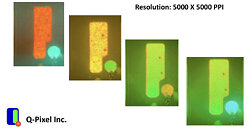TheLostSwede
News Editor
- Joined
- Nov 11, 2004
- Messages
- 18,899 (2.50/day)
- Location
- Sweden
| System Name | Overlord Mk MLI |
|---|---|
| Processor | AMD Ryzen 7 7800X3D |
| Motherboard | Gigabyte X670E Aorus Master |
| Cooling | Noctua NH-D15 SE with offsets |
| Memory | 32GB Team T-Create Expert DDR5 6000 MHz @ CL30-34-34-68 |
| Video Card(s) | Gainward GeForce RTX 4080 Phantom GS |
| Storage | 1TB Solidigm P44 Pro, 2 TB Corsair MP600 Pro, 2TB Kingston KC3000 |
| Display(s) | Acer XV272K LVbmiipruzx 4K@160Hz |
| Case | Fractal Design Torrent Compact |
| Audio Device(s) | Corsair Virtuoso SE |
| Power Supply | be quiet! Pure Power 12 M 850 W |
| Mouse | Logitech G502 Lightspeed |
| Keyboard | Corsair K70 Max |
| Software | Windows 10 Pro |
| Benchmark Scores | https://valid.x86.fr/yfsd9w |
Q-Pixel Inc., a Los-Angeles based stealth startup, announces the world's first full-color, ultra-high resolution microLED display, establishing a groundbreaking new milestone in the display industry. For the first time, using their proprietary Polychromatic microLED technology, Q-Pixel has achieved full-color LED display with a world record-breaking pixel density of 5000 pixels per inch (PPI), surpassing the current world record of 2000 PPI held by ITRI of Taiwan. Q-Pixel's revolutionary new technology is a game-changer to the display industry.


What are MicroLED Displays?
Since the invention of the first single color light emitting diode (LED), LED technology has since become ubiquitous in most electronic applications. In particular, in the display industry, it allows the bright, energy-efficient displays seen in today's televisions, smartphones, and wearable electronics. MicroLED displays are the sought-after Holy Grail of the display industry due to their high energy efficiency, faster response time, and higher pixel density. However, in the last two decades, full-color LED pixel density and display resolution have not seen much improvement. This is largely due to the manufacturing constraint of assembling individual red, green, and blue LEDs to achieve full-color gamut.
How is Q-Pixel altering the MicroLED display landscape?
Q-Pixel's proprietary Polychromatic microLED technology introduces full-color tunability across a single 4-micron pixel, replacing the century-old single-color LED and addressing several decades-long challenges to the microdisplay industry. Q-Pixel's tunable, full-color single-pixel LED eliminates the need for pick-and-place (a key bottleneck in traditional LED display assembly), while at the same time enabling ultra-high pixel density.
View at TechPowerUp Main Site | Source


What are MicroLED Displays?
Since the invention of the first single color light emitting diode (LED), LED technology has since become ubiquitous in most electronic applications. In particular, in the display industry, it allows the bright, energy-efficient displays seen in today's televisions, smartphones, and wearable electronics. MicroLED displays are the sought-after Holy Grail of the display industry due to their high energy efficiency, faster response time, and higher pixel density. However, in the last two decades, full-color LED pixel density and display resolution have not seen much improvement. This is largely due to the manufacturing constraint of assembling individual red, green, and blue LEDs to achieve full-color gamut.
How is Q-Pixel altering the MicroLED display landscape?
Q-Pixel's proprietary Polychromatic microLED technology introduces full-color tunability across a single 4-micron pixel, replacing the century-old single-color LED and addressing several decades-long challenges to the microdisplay industry. Q-Pixel's tunable, full-color single-pixel LED eliminates the need for pick-and-place (a key bottleneck in traditional LED display assembly), while at the same time enabling ultra-high pixel density.
View at TechPowerUp Main Site | Source






